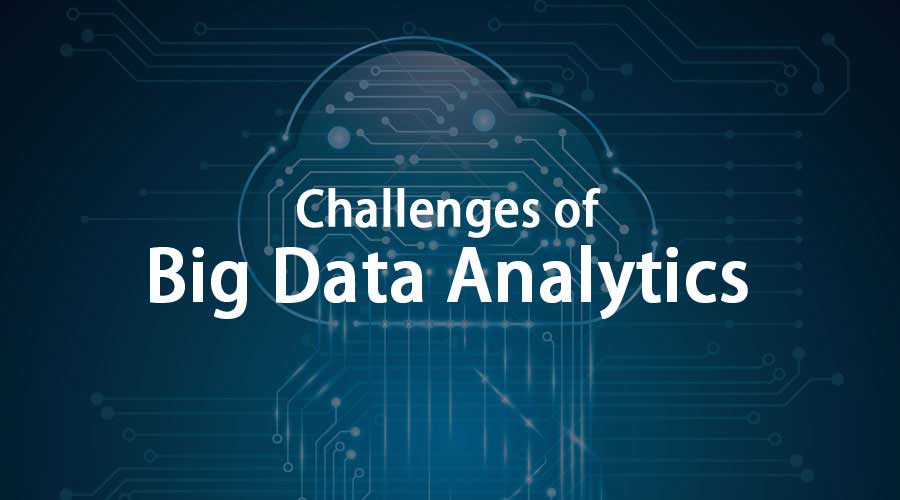
Introduction to Challenges of Big Data Analytics
Data is a very valuable asset in the world today. The economics of data is based on the idea that data value can be extracted through analytics. Though Big data and analytics are still in their initial growth stage, their importance cannot be undervalued. As big data starts to expand and grow, the Importance of big data analytics will continue to grow in everyday personal and business lives. In addition, the size and volume of data are increasing daily, making it important to address big data daily. Here we will discuss the Challenges of Big Data Analytics.
According to surveys, many companies are opening up to using big data analytics in their daily functioning. With the rising popularity of Big data analytics, it is obvious that investing in this medium will secure the future growth of companies and brands.
The key to data value creation is Big Data Analytics, so it is important to focus on that aspect of analytics. Many companies use different methods to employ Big Data analytics, and there is no magic solution to successfully implementing this. While data is important, even more important is the process through which companies can gain insights with their help. Gaining insights from data is the goal of big data analytics, so investing in a system that can deliver those insights is extremely crucial and important. Therefore, successful implementation of big data analytics requires a combination of skills, people, and processes that can work in perfect synchronization with each other.
Today, companies are developing at a rapid pace, and so are advancements in big technologies. This means that brands must be ready to pilot and adopt big data in such a manner that they become an integral aspect of the information management and analytics infrastructure. Today, big data is an emerging disruptive force of becoming the next big thing in integrated analytics, transforming how brands and companies perform their duties across stages and economies.
With great potential and opportunities, however, come great challenges and hurdles. This means that companies must be able to solve all the hurdles to unlock the full potential of big data analytics and its concerned fields. When big data analytics challenges are addressed in a proper manner, the success rate of implementing big data solutions automatically increases. As big data makes its way into companies and brands around the world, addressing these challenges is extremely important.
Major Challenges of Big Data Analytics
Some of the major challenges that big data analytics programs are facing today include the following:
- Uncertainty of Data Management Landscape: Because big data is continuously expanding, new companies and technologies are developed every day. A big challenge for companies is to find out which technology works bests for them without introducing new risks and problems.
- The Big Data Talent Gap: While Big Data is growing, very few experts are available. This is because Big data is a complex field, and people who understand this field’s complexity and intricate nature are far from between. Another major challenge in the field is the talent gap that exists in the industry
- Getting data into the big data platform: Data is increasing every single day. This means that companies have to tackle a limitless amount of data on a regular basis. The scale and variety of data available today can overwhelm any data practitioner, which is why it is important to make data accessibility simple and convenient for brand managers and owners.
- Need for synchronization across data sources: As data sets become more diverse, they must be incorporated into an analytical platform. It can create gaps and lead to wrong insights and messages if ignored.
- Getting important insights through the use of Big data analytics: It is important that companies gain proper insights from big data analytics, and it is important that the correct department has access to this information. A major challenge in big data analytics is bridging this gap in an effective fashion.
This article will look at these challenges in a closer manner and understand how companies can tackle these challenges in an effective fashion. Implementation of Hadoop infrastructure. Learn Hadoop skills like HBase, Hive, Pig, and Mahout.
-
Challenge 1
The challenge of rising uncertainty in data management: In a world of big data, the more data you have, the easier it is to gain insights from them. However, in big data, there are a number of disruptive technology in the world today, and choosing from them might be a tough task. That is why big data systems need to support both the operational and, to a great extent, analytical processing needs of a company. These approaches are generally lumped into the NoSQL framework category, which differs from the conventional relational database management system.
There is a number of different NoSQL approaches available in the company, from using methods like hierarchal object representation to graph databases that can maintain interconnected relationships between different objects. As big data is still in its evolution stage, there are many companies that are developing new techniques and methods in the field of big data analytics.
In fact, new models developed within each NoSQL category help companies reach their goals. These Big analytics tools are suited for different purposes as some provide flexibility while other heal companies reach their goals of scalability or a wider range of functionality. This means that the wide and expanding range of NoSQL tools has made it difficult for brand owners to choose the right solution to help them achieve their goals and be integrated into their objectives.
Choosing the wrong tool can be costly as it might not help the company reach its goals and also waste time and resources. Understanding this is extremely important for companies as only choosing the right tool and core data magnet landscape is the fine line between success and failure.
Image source: pixabay.com-
Challenge 2
The gap in experts in big data analytics: An industry completely depends on the resources it has access to, whether human or material. Some tools for big data analytics range from traditional relational database tools with alternative data layouts designed to increase access speed while decreasing the storage footprint, in-memory analytics, NoSQL data management frameworks, and the broad Hadoop ecosystem. With so many systems and frameworks, there is a growing and immediate need for application developers who have knowledge of all these systems. Despite the fact that these technologies are developing at a rapid pace, there is a lack of people who possess the required technical skill.
Another thing to remember is that many experts in the field of big data have gained experience through tool implementation and its use as a programming model instead of data management aspects. This means that many data tool experts lack knowledge about the practical aspects of data modeling, data architecture, and data integration.
This lack of knowledge will result in less than successful data and analytical processes implementations within a company/brand.
According to analyst firm McKinsey & Company, “By 2018, the United States alone could face a shortage of 140,000 to 190,000 people with deep analytical skills as well as 1.5 million managers and analysts with the know- how to use the analysis of big data to make effective decisions.
All this means that while this sector will have multiple job openings, there will be very few experts who will actually have the knowledge to fill these positions effectively. While data practitioners become more experienced through continuous working in the field, the talent gap will eventually close. At the same time, it is important to remember that when developers cannot address fundamental data architecture and data management challenges, the ability to take a company to the next level of growth is severely affected. This means that companies must always invest in the right resources, be it technology or expertise, to ensure that their goals and objectives are objectively met in a sustained manner.
-
Challenge 3
The challenge of getting data into the big data platform: Every company is different and has different amounts of data to deal with. While some companies are completely data-driven, others might be less so. That is why it is important to understand these distinctions before finally implementing the right data plan. Also, not all companies understand the full implication of big data analytics. Assuming that every company is knowledgeable about the benefits and growth strategy of business data analytics would seriously impact the success of this initiative. That is why it is important that business development analytics are implemented with the knowledge of the company.
As companies have a lot of data, understanding that data is very important because, without that basic knowledge, it is difficult to integrate it with the business data analytics program. Communication plays an integral role here as it helps companies and the concerned team educate, inform and explain the various aspects of business development analytics.
Before even going towards implementation, companies must a good amount of time explaining the benefits and features of business analytics to individuals within the organizations, including stakeholders, management, and IT teams. While companies will be skeptical about implementing business analytics and big data within the organization, once they understand its immense potential, they will easily be more open and adaptable to the entire big data analytical process.
-
Challenge 4
The challenge of the need for synchronization across data sources: Once data is integrated into a big platform, data copies are migrated from different sources at different rates. Schedules can sometimes be out of sync within the entire system. There are different types of synchrony. It is important that data is in sync. Otherwise, this can impact the entire process. With so many conventional data marks and data warehouses, sequences of data extractions, transformations, and migrations, there is always a risk of data being unsynchronized.
With exploding data volumes and the rising speed at which updates are created, ensuring that data is synchronized at all levels is difficult but necessary. This is because data is not in sync. It can result in analyses that are wrong and invalid. If inconsistent data is produced at any stage, it can result in inconsistencies at all stages and have disastrous results. Wrong insights can damage a company to a great degree, sometimes even more than not having the required data insights.
-
Challenge 5
The challenge of getting important insights through Big data analytics: Data is valuable only as long as companies can gain insights from them. By augmenting the existing data storage and providing access to end users, big data analytics needs to be comprehensive and insightful. The data tools must help companies not just have access to the required information but also eliminate the need for custom coding. As data grows inside, it is important that companies understand this need and process it in an effective manner. With the increase in data size on time and cycle, ensuring the proper adaptation of data is a critical factor in the success of any company.
Conclusion
These are just some of the few challenges that companies are facing in the process of implementing big data analytics solutions. While these challenges might seem big, it is important to address them in an effective manner because everyone knows that business analytics can truly change the fortune of a company. The possibilities with business analytics are endless, from preventing fraud to gaining a competitive edge over competitors to helping retain more customers and anticipating business demands. In the last decade, big data has come a very long way, and overcoming these challenges is going to be one of the major goals of the Big data analytics industry in the coming years.
Recommended Articles
This article has been a guide to the Challenges of Big Data analytics. Here we have discussed the basic concept and challenges of Big Data analytics. You may also look at the following article to learn more –


